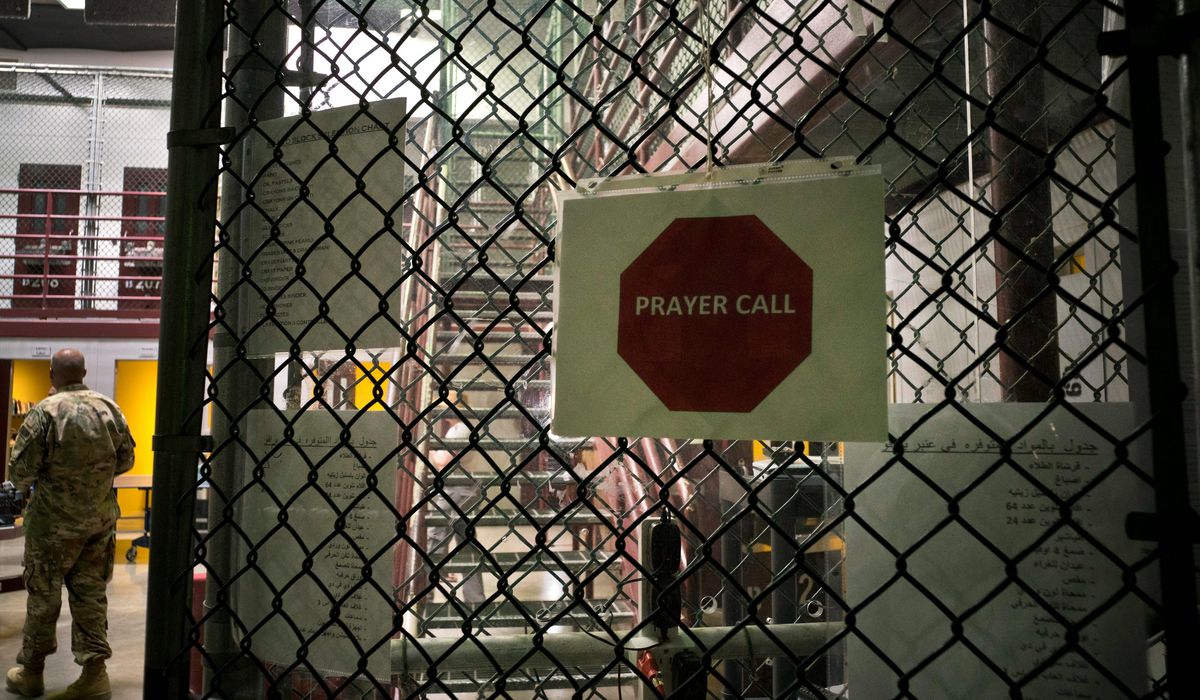

The Biden administration said Monday it has transferred a detainee from the Guantanamo Bay detention center back to his native country of Morocco, cutting the total number of prisoners at the controversial site in Cuba to 39 with more moves on the horizon.
Pentagon officials said Abdul Latif Nasir, an al Qaeda explosives trainer captured by U.S. forces during the early years of the war on terror, no longer needed to be housed at the facility.
It’s the first transfer of a Guantanamo prisoner since President Biden took office in January and a sign that the administration is prepared to forge ahead with the longstanding Democratic goal of shuttering the prison, which critics argue has outlived its usefulness, become a financial burden, and serves as a terrorist recruiting tool in some corners of the world.
Along with the unfolding U.S. military withdrawal from Afghanistan, the shuttering of Guantanamo would mark a symbolic turning point from the war on terror era that has dominated the American national security landscape for 20 years.
The imprisonment of Nasir, 56, had been under review for a decade, officials said, as part of a much broader effort started by former President Obama to dramatically reduce the number of Guantanamo detainees. The Defense Department’s Periodic Review Board (PRC) ultimately found in 2016 that it was no longer necessary to hold Nasir at the facility in Cuba.
The Defense Department’s Periodic Review Board (PRB) ultimately found in 2016 that it was no longer necessary to hold Nasir at the U.S. military facility in Cuba, but his release was held up throughout former President Trump’s tenure.
“In 2016, the Periodic Review Board process determined that law of war detention of Abdul Latif Nasir no longer remained necessary to protect against a continuing significant threat to the national security of the United States,” the Pentagon said in a statement. “Therefore, the PRB recommended that Nasir be authorized for repatriation to his native country of Morocco, subject to security and humane treatment assurances. The steps necessary to effectuate the repatriation were unable to be completed prior to the end of the Obama administration.”
“The United States commends the Kingdom of Morocco for its long-time partnership in securing both countries’ national security interests.” the Pentagon said. “The United States is also extremely grateful for the Kingdom’s willingness to support ongoing U.S. efforts to close the Guantanamo Bay Detention Facility.”
Nasir was captured in Afghanistan in January 2002 while trying to escape into Pakistan, according to a Defense Department memo released publicly by WikiLeaks. The memo said that Nasir had been an associate of al Qaeda leader and 9/11 mastermind Osama bin Laden.
Nasir worked with the terrorist organization as an explosives expert and weapons instructor. He also fought against U.S. and coalition forces in Afghanistan as a member of bin Laden’s 55th Arab Brigade, according to the memo.
His transfer leaves 39 detainees at the site. Of those, administration officials say another 10 “have been recommended for transfer” to their native countries or other destinations. Advocacy groups say action should be taken quickly for that group.
“The Biden administration urgently needs to negotiate and implement similar decisions for other cleared prisoners,” said Hina Shamsi, director of the national security project at the American Civil Liberties Union. “Bringing an end to two decades of unjust and abusive military detention of Muslim men at Guantanamo is a human rights obligation and a national security necessity.”
Another 17 Guantanamo prisoners are eligible to have their cases heard by the PRB, officials said, meaning they too could soon be recommended for transfer.
Another 10 detainees are moving through military commission proceedings, including Khalid Shaikh Mohammed, allegedly one of the key perpetrators of the 9/11 terrorist attacks. The remaining two prisoners have been convicted.
Should Guantanamo be closed, those who have been already convicted or may be found guilty in the future likely would need to be transferred to maximum-security prisons on the U.S. mainland — an idea that has met fierce resistance from lawmakers whenever it’s been floated over the past two decades.
Such resistance ultimately helped scuttle Mr. Obama’s efforts to close the facility, which is growing increasingly expensive as its prisoners age and require extensive medical care.
Though he did not close the prison, Mr. Obama did dramatically shrink its population from 245 to 41.
Mr. Trump, meanwhile, said he would fill Guantanamo with Islamic State terrorists and other “bad dudes” captured around the world. But he did not follow through on that promise. The Guantanamo population held steady during his presidency.
With their party back in control of the White House, Democrats on Capitol Hill have mounted their own renewed effort to cut funding for Guantanamo and effectively force it to close. Democrats on the House Appropriations Committee earlier this month released a draft defense budget that eliminates funding for the prison by the fall of 2022.
The push to close Guantanamo has divided lawmakers for years. While many argue the facility has become too expensive and in some corners of the world serves as a recruitment tool for extremists, others argue that the several dozen combatants left there are simply too dangerous to release.
• Joseph Clark and Mike Glenn contributed to this report.
